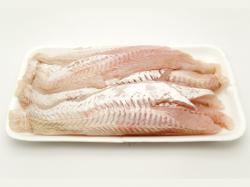Pacific Hake Mid-Water Trawl Fishery Earns MSC Re-Certification
December 8, 2014 | 4 min to read

The Pacific hake mid-water trawl fishery, which operates off the west coast of the United States and Canada, has achieved MSC re-certification following an independent, third-party assessment by certifier MRAG Americas. The mid-water trawl fishery first achieved MSC certification as a sustainable and well-managed fishery in the fall of 2009. Pacific hake (Merluccius productus) is also known commercially as Pacific whiting.
About the Pacific hake mid-water trawl fishery
The client group of the Pacific hake fishery includes both U.S. and Canadian participation. The U.S. members, led by the Pacific Whiting Conservation Cooperative (PWCC) and the Oregon Trawl Commission (OTC), represent the majority of the onshore and at-sea hake processing sectors and the vessels that harvest the catch. The Canadian client group is led by the Association of Pacific Hake Fishermen (APHF) who represent the majority of the harvesting sector.
The management of the Pacific hake fishery is shared jointly by an international agreement between the governments of Canada and the United States. A joint management committee recommends the annual Total Allowable Catch (TAC), while the National Marine Fisheries Service (NMFS) in the U.S. and the Department of Fisheries and Oceans (DFO) in Canada are responsible for domestic management of their country’s fisheries. In the U.S., the Pacific Fishery Management Council (PFMC) recommends management and enforcement measures to NMFS, while DFO in Canada meets regularly with the Groundfish Trawl Advisory Committee (GTAC), comprised of fishers, processors, coastal community leaders and labor, First Nations and the Province of BC to review the fishery and obtain information and advice on management actions, including catch data, stock movement and any potential joint venture opportunities to be allowed. In addition, Washington coastal tribes have treaty rights that are taken into account in the management of the fishery.
The annual TAC for the Pacific hake fishery has a fixed allocation of 73.88% and 26.12% for the U.S. and Canada, respectively. The primary commercial markets for Pacific hake are Europe, Asia and North America. It is used in producing a variety of products including surimi and frozen fillet, dressed and whole fish block markets.
Significant improvements achieved
“The combined efforts of the fishery client and fishery managers have resulted in significant completed improvements,” said Dan Waldeck, executive director, Pacific Whiting Conservation Cooperative. “The development of a robust U.S. and Canada Hake Treaty process with a shared vision of science-driven, sustainable management of the hake resource also contributed to the success of the re-certification of the fishery to the MSC standard.”
“The dedication and collaboration with DFO staff both in improving the fishery management process and in communications with industry and the public greatly helped with this achievement,” said Shannon Mann with the Association of Pacific Hake Fishermen.
“We congratulate the members of the Pacific hake mid-water trawl fishery on the re-certification of this fishery to the science-based, global MSC standard,” said Dan Averill, MSC fisheries outreach manager. “The substantial improvements continue to contribute to the success of the fishery as well-managed and sustainable for this and future generations.”
About the assessment and certification
MRAG Americas, an independently accredited certifier, was the certifier for this assessment against the MSC standard. During the assessment, the three principles of the MSC standard were evaluated in detail: the status of the fish stock, the impact of the fishery on the marine ecosystem and the management system overseeing the fishery. The fishery completed 24 total conditions during the initial certification period and achieved re-certification with the improved total of two conditions. More information about the Pacific hake mid-water trawl fishery and the complete Public Certification Report detailing the fishery’s passing scores against the MSC standard can be found on MSC’s web site at www.msc.org/track-a-fishery/certified.
Marine Stewardship Council
The Marine Stewardship Council (MSC) is an international non-profit organization set up to help transform the seafood market to a sustainable basis. The MSC runs the only certification and ecolabelling program for wild-capture fisheries consistent with the ISEAL Code of Good Practice for Setting Social and Environmental Standards and the United Nations Food and Agricultural Organization Guidelines for the Ecolabelling of Fish and Fishery Products from Marine Capture Fisheries. These guidelines are based upon the FAO Code of Conduct for Responsible Fishing and require that credible fishery certification and ecolabelling schemes include:
- Objective, third-party fishery assessment utilizing scientific evidence;
- Transparent processes with built-in stakeholder consultation and objection procedures;
- Standards based on the sustainability of target species, ecosystems and management practices.
The MSC has regional or area offices in London, Seattle, Tokyo, Sydney, The Hague, Beijing, Berlin, Cape Town, Copenhagen, Halifax, Paris, Madrid, Stockholm, Santiago, Moscow, Salvador, Singapore and Reykjavik.
In total, more than 340 fisheries are engaged in the MSC program with 243 certified and 102 under full assessment. Together, fisheries already certified or in full assessment record annual catches of close to ten million metric tonnes of seafood. This represents over eleven per cent of the annual global harvest of wild capture fisheries. Certified fisheries currently land over seven million metric tonnes of seafood annually – close to eight per cent of the total harvest from wild capture fisheries. Worldwide, more than 25,000 seafood products, which can be traced back to the certified sustainable fisheries, bear the blue MSC ecolabel.
For more information on the work of the MSC, please visit www.msc.org
Source: Marine Stewardship Council
